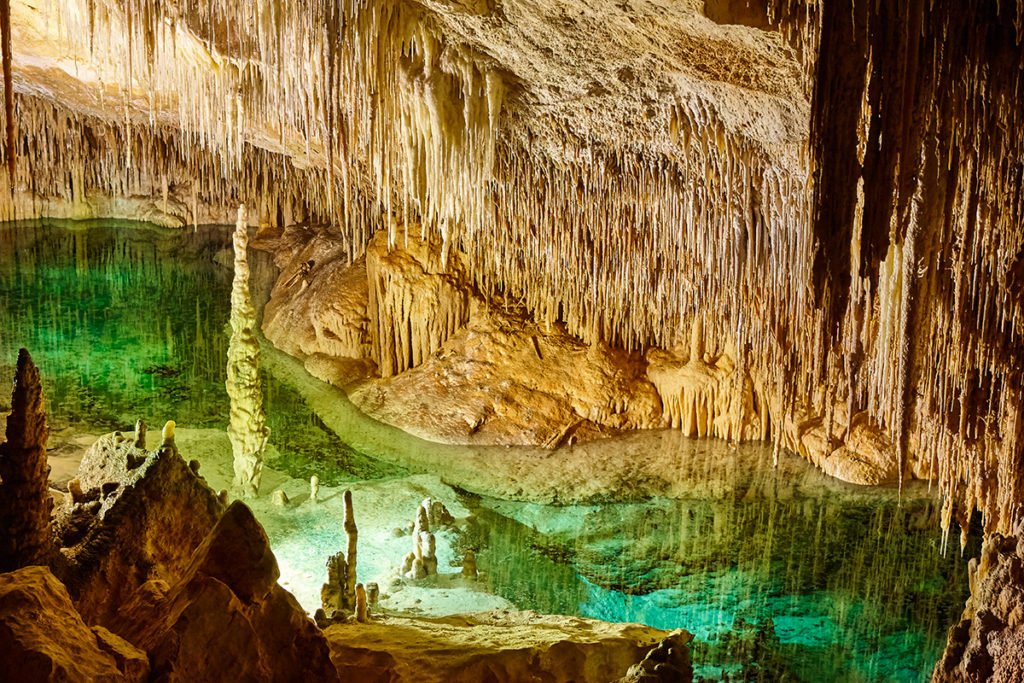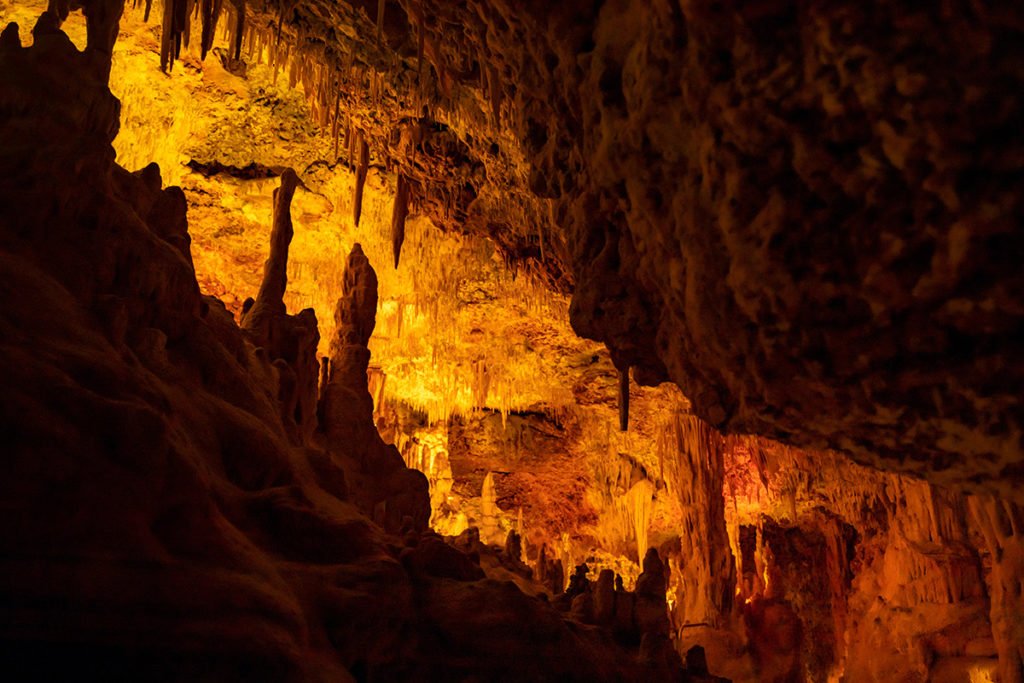The Balearic Islands are not only about golden beaches in Majorca and well-equipped resorts prepared to welcome any number of tourists. This time I invite you to visit the caves!
The caves in Mallorca are one of those places that should definitely not be missed during your stay on the island. Most of them have been well prepared for visitors, which has its advantages, but also a few disadvantages. The upside is that getting to each of the five most popular caves in Majorca is quite easy (although watch out for Cuevas del Drach and Cuevas dels Hams as their close location makes it sometimes possible to mistake one cave for another). Excellent light illuminations, music effects, creative guides and the atmosphere that prevails inside these places are praiseworthy too.
What is worth knowing?
When it comes to downsides, we will experience them mainly in the high season and they mainly concern Cuevas del Drach and Cuevas dels Hams. The more tourists, the more it becomes evident that Mallorca’s caves turn into a “production line” designed to serve as many visitors as possible in the shortest time possible. That’s life…
However, regardless of whether you plan your holiday in Mallorca in the middle of summer or off-season, these places are so interesting that it would be a sin not to see them. On the map below you can see their location, and a little further – a description of what each cave hides.
Dragon Caves (Cuevas del Drach)

Cuevas del Drach (cat. Coves del Drac) is actually not one, but four large caves: Cova Blanca, Cova Negra, Cova de Lluis Salvador and Cova dels francesos. You will find them near Porto Cristo, on the eastern side of the island.
Dragon caves were known as soon as in the Middle Ages (the first mentions of them come from 1338), but their deeper exploration didn’t take place until several hundred years later. The first map of the cave was created in 1880 by the cartographer M.F. Will. In 1896, E.A. Martel discovered new caves and one of the largest underground lakes in the world (over 100 meters long). As it is often the case with such places, not only the magnificent rock formations, but also their lighting make an impression. They were designed in 1935 by the Catalan engineer C. Buigas.
The Cuevas del Drach tour is approximately 1,200 meters long and takes approximately one hour. Apart from a walking trip, we also have a small boat trip on the underground lake Martel. There we will also see a short concert of classical music performed by musicians on board of one of the boats. Such concerts have been held here since 1935 and last more or less 10 minutes. They are short, but delightful, as caves are the best acoustic rooms that nature can create.
Fishook Caves (Cuevas dels Hams)

This cave was discovered in 1905. It owes its strange name to the stalactites hanging from the ceiling, which resemble hooks. However, they are not the only reason why it is worth seeing what’s inside. One of the attractions here is a concert of classical music. In the Cuevas dels Hams, it is additionally enriched with a multimedia show projected on the cave walls.
It is also worth adding that in Cuevas dels Hams, special events such as weddings, birthdays and banquets are organized.
Cuevas de Artà

Apart from the crowded Cuevas del Drach and Cuevas del Hams, Mallorca has another cave that is definitely worth visiting. It is of course Coves d’Artà near Cala Millor, which is considered by many to be the most beautiful cave in Majorca.
A visit here lasts about 40 minutes and begins once a group of a specified number of visitors is gathered (on average every half an hour).The impressive Reina de las Columnas (transl. Queen of Columns), the largest stalagmite on the island measuring 22 meters in height, waits for you inside.
Excellent lighting and illuminations are noteworthy too. It is thanks to them that in the interior of Cuevas de Artà we will see beautiful rock formations that will remind us again and again of various animals, plants and dragons.
Cuevas de Campanet

This cave complex can be found near Alcudia. The Cuevas de Campanet Cave covers an area of over 3000 m2 and was opened to visitors in 1948. Inside, apart from spectacular stalactites and stalagmites, you will also find a bar and, of course, friendly guides. However, Coves de Campanet is little known in Mallorca and is not as impressive as the caves mentioned above.
Coves de Gènova
This cave is the closest to Palma de Mallorca – it takes about 5 minutes from the city center to get there. Cuevas de Génova was discovered in 1906 and, like the other caves, its interior impresses you with its beautiful rock formations. Colorful lights make it even more charming and help you pay attention to the most interesting underground works of nature.
Discover Andalusia
Each region of Spain is divided into provinces. Their names often coincide with the names of their main cities. Catalonia is divided into eight provinces, each of which has different tourist attractions and interesting places to offer:| Province | Tourist attractions and interesting places |
| Almería | Tabernas Desert (Desierto de Tabernas), Oasys MiniHollywood Amusement Park, Fort Bravo Amusement Park, Castillo de Tabernas (castle), Cabo de Gata Natural Park, Sierra Alhamilla Mountains. Popular cities: Almería |
| Cádiz | Doñana National Park. Popular cities: Cádiz, Setenil de las bodegas, Jerez de la Frontera, Arcos de la Frontera |
| Córdoba | La Mezquita. Popular cities: Córdoba |
| Granada | Alhambra. Popular cities and regions: Granada, Sierra Nevada |
| Huelva | Doñana National Park. Popular cities: Huelva |
| Jaén | Popular cities: Jaén |
| Málaga | Gibralfaro Castle, La Alcazaba, Cathedral in Malaga, Roman Theatre, Picasso Museum, Caminito del Rey, Palacio Episcopal, Museo Carmen Thyssen Málaga, Sierra de las Nieves Natural Park, Serranía de Ronda Mountains, La Ciudad Romana de Acinipo (ancient ruins), Cueva de la Pileta Cave, Bioparc Fuengirola, Orchidarium Estepona, Parque Acuático Mijas, Reservatauro Ronda Natural Park, Aquarium Sea Life Benalmádena, Selwo Aventura, Castillo de San Luís (castle ruins), Plaza de Toros in Ronda, Museo Lara in Ronda, Alameda del Tajo, Iglesia de Santa María la Mayor in Ronda (church), Iglesia del Espíritu Santo in Ronda (church), Puente Nuevo (New Bridge) i Puente Viejo (Old Bridge), El Tajo abyss in Ronda, Mondragón Palace, Water Mine and Casa del Rey Moro, La Ermita de la Virgen de la Cabeza, Bandits' Museum (Museo del Bandolero), Beaches in Benalmadena. Popular cities: Málaga, Ronda, Marbella, Torremolinos, Fuengirola, Benalmádena, Estepona, Cuevas del Becerro, Jimera de Líbar, Mijas, Villanueva de Tapia, La Línea de la Concepción, Bahía Dorada Coast, San Pedro de Alcántara |
| Seville | Cathedral in Seville (Catedral de Santa María de la Sede de Sevilla), Alcazar de Sevilla, India Archive, Gold Tower, Barrio de Santa Cruz district, Casa de Pilatos, Museum of Fine Arts, Maria Luisa Park (Parque de María Luisa), Plac Hiszpański (Plaza de España), Metropol Parasol, Itálica (archeological site), Doñana National Park. Amusement Parks: Isla Mágica, Aquopolis Sevilla, Aventura Sevilla. Popular cities: Seville |



